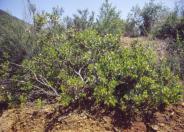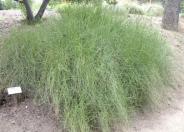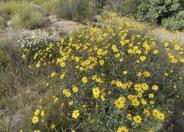
Common name:Big Cone Douglas Fir
Botanical name:Pseudotsuga macrocarpa
Bigcone Spruce, Pseudotsuga macrocarpa, is native to the mountains of Southern California from 1500' to 6000'. At the lower elevations, these trees hide in north side ravines along the desert edge. Bigcone Spruce is visible in spots from the I-5 and the 118 on the north side of the L.A. basin. In San Diego County, it's visible on Palomar and on some of canyon roads leading to the desert. Some of the areas that it clings to are amazing; everything looks dead and there's these evergreens. But it also grows in some of the coastal mountains such as Santa Ynez Mts, the mountains around Ojai and Mt. Wilson. This evergreen tree grows to 40-60' tall with a 20-30' width. (But in a home garden, expect 10-15 feet after ten years.) Very dark green foliage. I think this tree could be used throughout California as a drought tolerant tree to replace the non-drought tolerant Coast Redwood. Although the tree is hardy to -10 or below, I'd not try it in really cold spots. It would be happier in Los Angeles, not Tahoe. It might make it in Tahoe, but other trees would do better. This California native tree should be more widely planted. One of our customers planted this tree from a gallon into an old sand dune in Nipomo, in 7 years it had grown to maybe 10 foot tall and was covered with cones. He mulched the ground with chips from the local arborist and watered a few times the first year. No water system, no soil amending. beach sand, and the tree was beautiful. A perfect little Christmas Tree that tolerates containers. Flowers are insignificant.

Common name:Deer Grass
Botanical name:Muhlenbergia rigens
The deer grass is a warm season perennial that forms dense clumps from the base. The spike like flower stalks grow 2-3 ft. tall and this grass has striking foundation form. The deer grass is native to California, is drought tolerant, and is a beneficial insect plant. -Cornflower Farms

Common name:Rainbow Manzanita
Botanical name:Arctostaphylos rainbowensis
Arctostaphylos rainbowensis is a rare and endangered species of manzanita known by the common name Rainbow Manzanita. It is endemic to California, where it is known only from northern San Diego and southern Riverside Counties in the Peninsular Ranges. Previously called A. peninsularis ssp. peninsularis or considered to be a hybrid between A. glandulosa and A. glauca. It has now been established as its own species. Height varies from 3' to 10'. It grows from a basal burl and exhibits the typical attractive reddish brown bark. This manzanita thrives in tough conditions, with minimal irrigation needed. It will stand very hot temperatures, light freezes and full sun. It tolerates decomposed granite, sandy and rocky soil, growing in poor soils, so long as they are fairly well-drained. Rainbow Manzanita has beautiful red bark and an evergreen habit. Upside-down, bell-like flowers are formed in clusters, followed by plump, red-brown fruits. Rainbow Manzanita has a mounding habit, staying about 4' high and spreading to about 4-6' wide. Established plants are drought tolerant. It attracts wildlife and tolerates frost. Very attractive.

Common name:Desert tea, CA ephedra
Botanical name:Ephedra californica
This unusual looking shrub appears to be leafless. Leaf stems are gray green when new, changing to yellow gray with maturity. Tiny leaves grow at the nodes. This plant may reach 3' tall and 4-'5' wide. This plant is found in desert areas of AZ, So. CA and Baja CA. Many folks put the twigs in boiling water to make a medicinal tea. This plant prefers full sun, well draining and sandy soil. It is drought tolerant once it's established.

Common name:Slender Sunflower
Botanical name:Helianthus gracilentus
Helianthus gracilentus is a perennial herb that is native to California and is found only slightly beyond California borders. It is a species of sunflower known by the common name slender sunflower. Slender sunflower grows 2'- 6' tall and to 3'-6' wide. Even with no summer water (after it’s established), its foliage remains a fresh green thru the Fall. It will bear hundreds of cheery, 2”, bright yellow, chocolate scented daisies May to October. Semi-deciduous along the coast. Frost hardy, it returns each Spring after freezing. Excellent habitat plant & much loved nectar source for butterflies. Drought tolerant and deer resistant. Does best in full sun with sandy, well draining soil.
Designer:
Photographer: Vicki Anderson
Maintain a two to four inch layer of mulch on the soil surface to reduce weeds, infiltrate rain water, and reduce compaction.
Drip and other smart irrigation delivers water directly to roots, allowing no excess water for weeds.